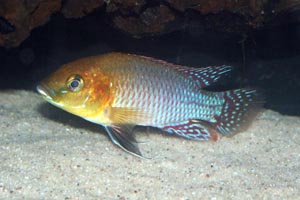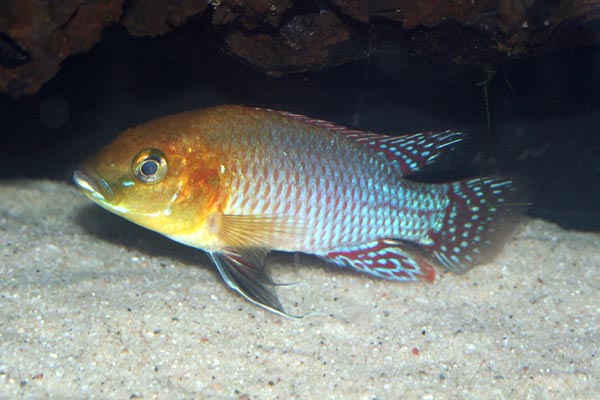

Species Profile | Images | Breeding Report | Similar Species

(Other members of the genus Pseudocrenilabrus)
ADULT SIZE: 7 cm
WATER CONDITIONS: Not critical
TEMPERATURE RANGE: 24-28 C
FOOD: Feed Pseudocrenilabrus nicholsi live and dried foods
DISTRIBUTION: This species comes from Congo (DRC)
SEXUAL DIFFERENCES: Males are significantly larger and more brightly coloured.
AQUARIUM CARE: A hardy African dwarf cichlid, that likes a well planted tank, with lots of hiding places. A hareem of one male to several females is ideal.
BREEDING: This is an easy to breed species. A typical matriachal mouthbrooder. Females should be separated in smaller tanks, to give them and the fry some peace and quiet.
Have you bred Pseudocrenilabrus nicholsi? Why not fill in a breeding questionaire?, or examine existing Pseudocrenilabrus nicholsi breeding reports
Other members of the genus Pseudocrenilabrus
Other cichlid species
Other species from Congo (DRC)

A colourful male.
BREEDING: This is an easy to breed species. A typical matriachal mouthbrooder. Females should be separated in smaller tanks, to give them and the fry some peace and quiet.
Have you bred Pseudocrenilabrus nicholsi? Why not fill in a breeding questionaire?
This page summarises breeding reports provided by visitors to this site, along with some statistical analysis. Please feel free to contribute - whatever your experience!
| |||||||||
|
| ||||||||
|
| ||||||||
|
| ||||||||
|
| ||||||||
Remember, each record represents only one persons experience; if you had different results, or used different methods, please share your experiences
| Water conditions: Neutral | Water temperature: 20-23oC |
| Disposition: Active, but not aggresive | Community tank?: Only with species of similar size |
| Spawning Method: Long term (fry appear with adults) | Breeding problems: Skewed sex ratio |
| Sex ratio: Somewhat female heavy | Breeding difficulty: Very easy |
| Sucess: Very unsucessful | Years Experience: 11 |
| Other Comments: | |
| Date this record created: 11th January 2011 | Breeding date: 1995 |
| Breeder: chris | Location: UK |